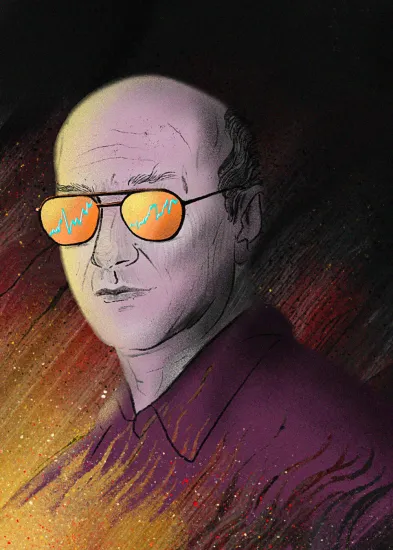
Illustration by II
At first glance, the United States Investing Championship seems like a straightforward investment contest.
Traders pay a fee to join and spend a year trying to juice their portfolios for the highest investment return before one competitor is crowned the victor in December.
But the story behind the competition’s founder, Norman Zadeh, who revived it in 2019 after a more than 20-year hiatus, isn’t that of a storied investor.
Zadeh is both a shapeshifter and a name-dropper. He goes by Zadeh, or Zada, depending on the day. He’s a poker king, a porn magazine magnate, Joan Rivers’ former “boy toy,” an intellectual property warrior, a wealthy man who lost a lot of money.
“I am the classic ‘do whatever I don’t do’ investor,” Zadeh said in an interview with Institutional Investor. “When I buy, you should be selling, and when I sell, you should be buying.”
So how did he come to establish a contest that, in its earlier iteration, attracted the likes of legendary investors like Paul Tudor Jones and Mark Strome?
Norman Zadeh’s father spent much of his career at University of California, Berkeley, and at one point, it seemed as though Norman would follow a similar path.
He earned a PhD from UC Berkley in 1972 in applied mathematics and published a book on poker two years later. Zadeh spent roughly ten years as a professor, teaching at Stanford University and UC, among other universities.
In the early ‘80s, Zadeh noticed that it seemed like “everyone was making money” investing. While Zadeh himself was not trading, he saw an opportunity: a contest for these traders to compete against each other.
By his own estimation, there were about 60,000 brokers in the market at the time. If he charged each $100 for a competition entry, he figured, he could be a millionaire six times over.
Things didn’t quite work out that way: in the first year, just 74 competitors signed up, and Zadeh ended up charging $75 a pop.
But thanks to press coverage — which Zadeh noted wasn’t all positive — the competition grew. He eventually upped the ante, requiring investors to have $1 million at a minimum to invest. The competition started to attract big-name investors.
“In American sports, it’s the Super Bowl, the World Series, and the NBA Finals,” wrote Mark Minervini in a 2019 blog post. “In entertainment, there’s the Academy Awards, the Emmy Awards, and the Tony Awards. Trading is no different.” In his view, the trading competition was exactly that.
Eager to join the ranks of those big-name traders, Minervini joined the 1996 competition. And then it got shut down.
In 1996, during Minervini’s run for best-trader, the SEC launched an investigation into the competition and Zadeh’s firm, effectively shutting down the contest.
“We were soliciting people and didn’t know them well enough,” Zadeh said. The SEC issued a cease-and-desist order in 1998. Zadeh added that he and his partner only had to pay a fine — the SEC’s order shows his payment was $165,000.
According to the trading competition’s website, Zadeh was “quite successful” at managing money until 2001. By then, his fortune had swelled. “You start making money and you start feeling invincible,” he said. He wanted to spend it. His first thought? A strip club.
“What do guys always want to do?” he joked. A woman he was seeing had tried to get featured in Playboy, only to be rejected. Zadeh, in a bid to make her feel better, decided to start his own adult magazine, one that focused solely on women who had not had plastic surgery.
And so, Perfect 10 was born.
In 2009, his home was featured on Joan Rivers’ TV Land series, How’d You Get So Rich? They filmed the episode — and soon after, Zadeh received a call from Rivers’ producer.
To hear Zadeh tell it, Rivers’ producer said the comedian wanted to “proclaim him her boy toy.” He flew out to New York to see her. The two had a public lunch that was photographed by the paparazzi.
“Only someone as brilliant as Joan Rivers could come up with this,” Zadeh said. “She was Ms. Plastic Surgery and I ran a magazine about natural women.” The relationship, Zadeh lamented, was not real. Soon after the rumors began, Rivers told TMZ that the two were just friends.
All along, the internet was changing: porn became more accessible, cheaper, and eventually free.
Zadeh was furious. Websites had taken both thumbnails and full spreads and films from Perfect 10 and republished them without credit or payment. He filed a series of lawsuits against tech companies like Google, Amazon, and Microsoft, claiming intellectual property theft.
But judges decided against him. All told, according to Zadeh, the magazine venture cost him “$51 million, plus my health.”
“That’s why I'm going back to what I used to do,” he said.
Zadeh runs two competitions: the United States Investing Championships and the Money Manager Verified Ratings. The premise for each is simple: pay a fee, provide an account number, and report earnings, calculated by percent return per month or quarter, depending on how frequently the trader shares information.
At the year’s end, the trader with the highest return wins. The spoils? A certificate from Zadeh and his help in connecting with others in the industry.
“The main winning is the recognition,” Zadeh said. And the competitors say it’s worth it.
“He can build a lot of bridges for new traders and help showcase their talents,” said Leif Soreide, who won the 2019 competition, the first since its hiatus. Soreide works in marketing for a securities-focused law firm.
“The first time I talked to Norm, he said, ‘do you want to be the next Paul Tudor Jones?’” Soreide said. (Jones declined to comment for this story.)
“I’m like obsessed with the markets,” Matthew Caruso, one of this year’s competitors, said by phone. He added that “all the greats” like Jones, David Ryan, and Marty Schwartz ran in the competition back in the ‘80s.
“When I saw last year that he started it again, I wanted to get involved,” Caruso said. “This is the competition everyone revered.”
Caruso, who used to trade for Canadian National Bank Financial, has been trading for himself for six years.
“It gets a little bit boring without the guys on the trading desk,” Caruso said. “I thought it would be fun to get involved.” So far, Caruso is up 426.2 percent through September — topping out the stock division.
For his part, Zadeh has been hunkering down during the pandemic. He wrote an independently published book on poker — his second on the subject.
“I can win at poker,” Zadeh joked. “I can’t win at the market.”





